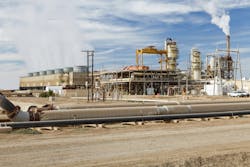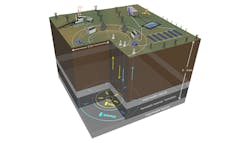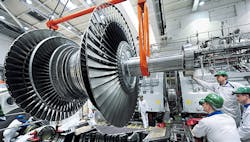The international accord drafted by 195 countries at the Paris climate talks last year is focused on keeping the average global temperature increase below 1.5 degrees Celsius. The agreement will require not only using more renewable energy and reducing carbon emissions, but also a reevaluation of how a renewable power grid will work.
Now, a research team led by the Lawrence Livermore National Laboratory (LLNL) in California has proposed a new method for satisfying these requirements. Writing in the journal Mechanical Engineering, the researchers outlined a system that uses carbon emissions from power plants to store renewable energy for the power grid.
The system, which the research team described as a vast underground battery, would store thermal energy in underground carbon dioxide reservoirs when demand on the power grid was low. The system would convert that energy into electricity and dispatch it to the power grid when demand is high.
The research comes as wind turbines, solar farms, and other renewable sources are increasingly being used in a power grid dominated by “baseload” power plants, which generate a constant flow of electricity. In contrast, the power output of renewable sources varies widely based on the time of day, seasons, location, and weather.
According to Thomas Buscheck, the paper’s author and director of LLNL’s Geochemical, Hydrological, and Environmental Science division, if “you want to store the large quantities of renewable energy necessary to balance seasonal supply-demand mismatches and store it efficiently, we believe the best way to do that is underground.”
The underground storage system involves pumping supercritical CO2, a highly concentrated liquid version of carbon dioxide, into highly porous and permeable sedimentary rock. Once underground, the highly pressurized CO2 pushes brine trapped in the rock up production wells. At the surface, the brine can be heated by energy from concentrating solar power plants, wind turbines, and nuclear and other baseload power plants.
Once heated, the brine is sent into the reservoirs to store thermal energy. The geothermal heat and huge amount of pressure underground prevent significant heat loss. When renewable energy cannot fulfill power grid demands, the pressurized CO2 and brine can both be released and their thermal energy converted to power. The brine could be used in a steam-powered generator, while the heated CO2 could drive turbines by itself. Both fluids could be reheated and sent back down into the reservoirs.
Another benefit of the system is that it locks away CO2 that would otherwise be released into the atmosphere, fueling climate change. Buscheck says at least four million tons of CO2 could be stored underground each year over 30 years. That is equivalent to the CO2 impact of a 600-megawatt coal plant. To relieve the enormous pressure of the stored CO2, which will make it difficult to keep underground permanently, some of the brine could be removed to create water through desalination.
Burning fossil fuels to generate electricity accounts for about 31% of the carbon dioxide emissions in the United States—more than any other source, including transportation. This translates into more than two billion metric tons of carbon emissions per year, according a 2013 study by the Environmental Protection Agency.
Buscheck says the United States is a very suitable candidate for the new system, but his reasons are less about the country’s carbon footprint and more about its geology. The sedimentary rock formations required for this system cover about half of the United States, he says.
The project falls within the U.S. Energy Department's Grid Modernization program, which aims to integrate renewable energy sources into the grid, while making it more resilient and secure against cyberattacks. On Thursday, Energy Secretary Ernest Moniz announced that the laboratory would start 14 new power grid research projects this year. Buscheck and his LLNL colleagues worked on the project with researchers from Ohio State University, the University of Minnesota, and Terracoh Inc., a company that designs underground CO2 storage systems.
The underground battery concept has been in development for seven years and the researchers "have shown the potential technical feasibility" of the approach in computer models, Buscheck said in an email. Buscheck adds that more research is necessary due to the heterogeneous nature of the sedimentary rock. Fundamentally, however, “the concept is based on proven technology,” he says. “There are no showstoppers.”
Correction February 21st, 2016
This article has been updated with new information provided by Thomas Buscheck in an email to Electronic Design. An earlier version of this article said that supercritical carbon dioxide and heated brine would be pumped into tunnels carved into sedimentary rock. Buscheck replied, "it is not necessary to carve openings in that rock. Moreover, it would probably be problematic to carve openings in sedimentary rock (which often lacks strength) because it could lead to geomechanical instability." Also, an earlier version of this article said that the underground battery had been "validated" in computer models. Buscheck disputed the accuracy of that word, saying that fields trails would be necessary to validate the idea.
About the Author
James Morra
Senior Editor
James Morra is the senior editor for Electronic Design, covering the semiconductor industry and new technology trends, with a focus on power electronics and power management. He also reports on the business behind electrical engineering, including the electronics supply chain. He joined Electronic Design in 2015 and is based in Chicago, Illinois.



